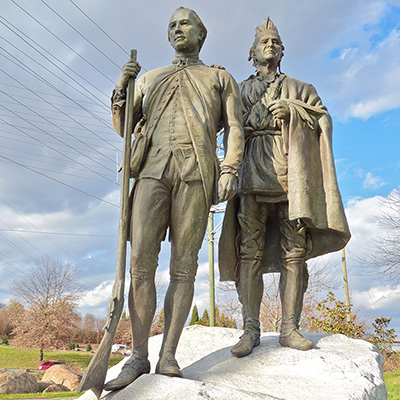
Thomas Spratt and King Haigler, Charlotte
Chas Fagan, Charlotte, NC, Sculptor
The bronze statue to Thomas "Kanawha" Spratt and Catawba Chief King Haigler stands on a 9-ton boulder with the lines of the Catawba River, Sugar Creek and the settlement of the Catawba etched into the stone along with petroglyphs of a turtle, snake and a fish. The boulder is a quarry stone carved to look like one formed by glacial action in the distant past. The stone was set into the ground angling upwards. The figure of Spratt stands in front of but lower and to the proper right of King Haigler with Haigler’s right hand resting on Spratt’s left shoulder. Each figure stands seven and one-half feet tall. Spratt’s attire is that of the Colonial frontier circa 1700. His head is bare and he is holding the barrel of a musket with his right hand and the stock resting on the ground. Haigler is wearing pants, a cloth jacket or blouse tied at the waist with a blanket over this left arm. Hanging from his neck is a sheathed knife. He is wearing a headband with several feathers inserted above the headband.
December 5, 2014
35.220140 , -80.830020
View in Geobrowse
"Lord Dunmore’s War,” Encyclopedia Britannica 2017, www.britannica.com, (accessed 14 July 2023) Link
Cashion, Jerry C. “Hagler (Artaswa Or Oroloswa), NCpedia.org, (accessed June 28, 2023) Link
DePriest, Joe. “Trail of Statues Honors Friendship From 1700s That Helped Shape Charlotte,” WBTV, (accessed June 28, 2023) Link
Moore, David G. 2006, revised October 2022. “Catawba Indians,” NCpedia.org, (accessed July 14, 2023) Link
Williams, Jim. “Thomas ‘Kanawha’ Spratt,” The Charlotte Museum of History, charlottemuseum.org, (accessed June 28, 2023) Link
“Thomas Spratt & King Haigler,” Trail of History, charlottetrailofhistory.org, (accessed June 28, 2023) Link
“Thomas Spratt and King Hagler Sculpture,” Carolina Bronze Sculpture, carolinabronze.com, (accessed June 28, 2023) Link
“Thomas Spratt and King Hagler,” Charles Fagan Fine Art, chasfagan.com, (accessed June 28, 2023) Link
“Trail of History-Thomas Spratt and King Hagler,” YouTube.com, (accessed June 28, 2023) Link
Yes
Bronze
Trail of History Inc.
King Haigler was a chief of the Catawba Indians who presided over the tribe from 1749 until his death in 1763 when historians believe he was ambushed and killed by a party of Shawnee. Haigler’s time as chief was one of great turmoil for the Catawba as their traditional enemies the Shawnee and the Cherokee as well were raiding Catawba villages. It was also a time when European settlers were moving into the backcountry of the Carolinas and several epidemics had also weakened the tribe. King Haigler allied himself with the new settlers and negotiated a number of treaties with both North and South Carolina, guaranteeing safety and support for his people and protection for the settlers. His people fought alongside the English in the French and Indian War but later took the American side in the Revolution.
Thomas “Kanawha” Spratt was among early settlers to what is now Mecklenburg County. His father, also named Thomas Spratt had purchased land near present-day Fort Mill, SC in 1750 and later added two plantations in the area of Anson County that later became Mecklenburg County. Spratt inherited most of this land upon his father’s death in 1757. Although these lands were originally purchased from North Carolina they were a part of 225 square miles the state gave to the Catawba Indians in 1763. Spratt and his descendants then leased the land for many years from the Catawba. Spratt was known as a friend to the Catawba and fought with them against their blood enemies the Shawnee. In 1774 during Lord Dunmore’s War he was given the name “Kanawha” by the Catawba for a battle fought against the Shawnee near the Kanawha River in present-day West Virginia. Spratt was later an officer for the Patriot cause during the Revolution. He remained a friend and supporter of the Catawba for the remainder of his life.
The statue is located on the Trail of History near the fountain on the campus of Central Piedmont Community College near downtown Charlotte. This statue is one of 21 existing or planned statues along the trail, the first of which was The Spirit of Mecklenburg.
The Trail of History near uptown Charlotte follows the Little Sugar Creek greenway. The greenway runs four miles along the small stream lined with trees, shrubbery, flowering plants and places for seating.
 Know anything else about this monument that isn't mentioned here? If you have additional information on
this or any other monument in our collection fill out the form at the Contact Us link in the footer. Thank you.
Know anything else about this monument that isn't mentioned here? If you have additional information on
this or any other monument in our collection fill out the form at the Contact Us link in the footer. Thank you.

